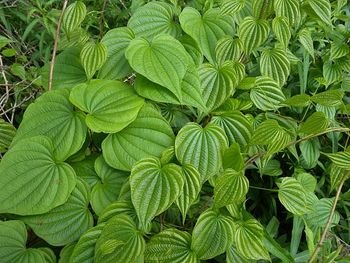Wild Yam
Other Names : American Yam, Atlantic Yam, Barbasco, China Root, Colic Root, Devil's Bones, DHEA Naturelle, Dioscorea, Dioscoreae, Dioscorea alata, Dioscorea batatas, Dioscorea composita, Dioscorea floribunda, Dioscorea hirticaulis, Dioscorea japonica, Dioscorea macrostachya, Dioscorea mexicana, Dioscorea tepinapensis, Dioscorea villosa, Dioscorée, Igname Sauvage, Igname Velue, Mexican Yam, Mexican Wild Yam, Ñame Silvestre, Natural DHEA, Phytoestrogen, Phyto-œstrogène, Rheumatism Root, Rhizoma Dioscorae, Rhizoma Dioscoreae, Shan Yao, Wild Mexican Yam, Yam, Yuma.
Wild yam has been used for centuries by Native Americans and early Americans for treatment of a variety of ailments. The herb, also known as colic root, has a relaxing effect. As the name suggests, an early use was to relieve colic in babies. Be sure to consult your child's pediatrician before giving your child any alternative treatment. But there are several other ways that wild yam can be used to improve health.
See also : Dioscorea Villosa (Homeopathy)
Special Precautions of Wild Yam
- Be careful not to use the fresh plant, because MedicinalHerbInfo.org warns that it can cause vomiting. Instead, purchase wild yam capsules, or the extract can be used to make an herbal tea.
- Use of wild yam is not recommended for pregnant women or for children.
- Hormone-sensitive condition such as breast cancer, uterine cancer, ovarian cancer, endometriosis, or uterine fibroids: Wild yam might act like estrogen. If you have any condition that might be made worse by exposure to estrogen, don’t use wild yam.
- Protein S deficiency: People with protein S deficiency have an increased risk of forming clots. There is some concern that wild yam might increase the risk of clot formation in these people because it might act like estrogen. There is one case report of a patient with protein S deficiency and systemic lupus erythematosus (SLE) who developed a clot in the vein serving the retina in her eye 3 days after taking a combination product containing wild yam, dong quai, red clover, and black cohosh. If you have protein S deficiency, it’s best to avoid using wild yam until more is known.
The benefits of Wild Yam are
- Menstruation & Menopause Relief : The University of Maryland Medical Center tells us that because of its antispasmodic properties, wild yam is often used to relieve menstrual cramps and pain from endometriosis. The Alternative Nature Online Herbal website states that wild yam is also commonly used to help relieve the uncomfortable symptoms of menopause such as hot flashes, night sweats and mood changes. However, wild yam has not been proven effective for these ailments in clinical studies. Make a tea by adding 1 tsp. of powdered wild yam root to 1 cup of hot water and simmering for 30 minutes. No more than one cup of the tea each day is recommended.
- Blood Sugar and Cholesterol Regulation : According to the U.S. National Library of Medicine, wild yam contains a substance called dioscoretine, which has lowered blood sugar levels in animal studies. In a separate study, the U.S. National Library of Medicine states that a substance contained in wild yam, diosgenin, was shown to be very promising in raising HDL (the "good" cholesterol) and lowering LDL (the "bad" cholesterol).
- Digestion Aid : Another use for wild yam is to aid digestion, as explained on MedicnalHerbInfo.org. Wild yam tea is helpful in alleviating flatulence and generally improving the function of the liver and gall bladder. As in the previous treatments, the clinical studies are inconclusive even though some people swear by the herb.
- Contains Inulin prebiotic.
- wild yam contains antioxidant and anti-inflammatory properties, making it useful in treating other ailments, such as asthma, neuritis and rheumatoid arthritis, and for regulating the metabolism. Again, there are no studies that confirm its effectiveness. Be sure to check with your physician or pharmacist to make sure there will be no harmful interaction with any medications you are already taking for these conditions.
